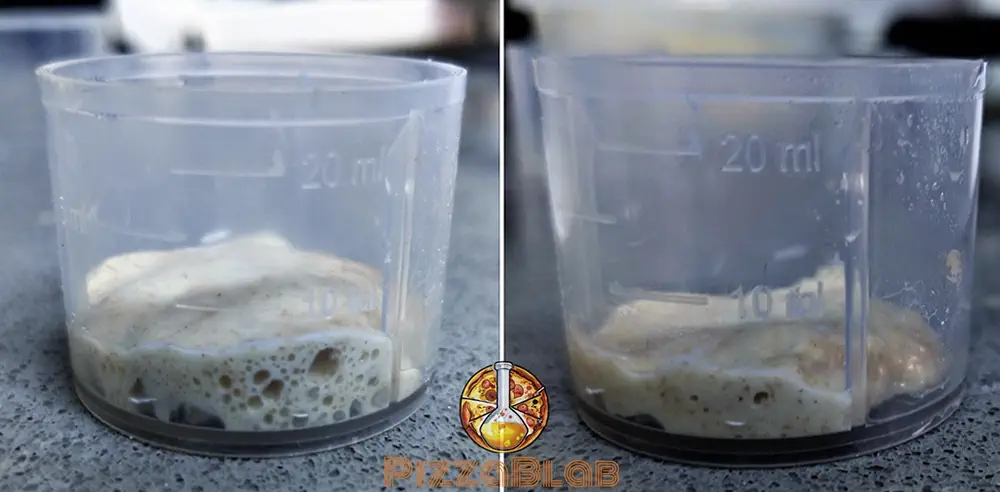How to Tell if the Dough is Ready for Baking: 4 Dough Fermentation Tests
Determining the perfect moment to bake your dough is crucial for achieving optimal results in pizza (and also bread) making. In this article, we will learn how to perform four essential dough fermentation tests: the Bubbles Test, the Volume Test, the Finger Poke Test, and the Shake Test. These tests will help you evaluate your dough’s fermentation progress and determine the ideal time to begin baking, ensuring the best possible results
Dough Test Guidelines and Expectations
Below are four tests that can help determine the condition of the dough and whether it is ready for baking. Keep in mind that while these tests can assist in assessing the dough’s condition, they are not definitive or set in stone.
Ultimately, there is no substitute for baking experience. With time and practice, you will develop a sense of when the dough is ready to be baked and has reached the optimal point of fermentation, neither under-fermented nor over-fermented; But until then, the following tests can serve you well.
Each test can be used individually or in combination with others. Personally, I recommend using the volume test and the bubble test, especially when making pizza dough.
The Bubbles Test
This test is my personal favorite and the one I recommend using, because it provides a fairly accurate assessment of the fermentation state of the dough. To conduct this test, it is necessary to ferment the dough in a transparent container.
The rationale behind this test is the yeast activity, which generates “air bubbles” (CO2) in the dough that can be observed through the transparent container. The presence of a sufficient number of bubbles indicates adequate yeast activity in the dough.
To perform this test, simply examine the dough through the bottom of the container and look for bubble formation at the bottom. Ideally, we want to see a lot of medium-sized bubbles.
If there are too few bubbles or they are very small, it means the dough is under-fermented. If there are too many bubbles and/or they are very large, it indicates over-fermentation of the dough.
Note that the bubbles test is used to evaluate the fermentation state of the dough after the final shaping (for pizza dough – after dividing into balls; for bread dough – after the final shaping).

The exact size of the bubbles may vary depending on factors like the flour used and its properties (specifically elasticity and extensibility), the use of preferments, dough hydration, and more. That said, the picture above serves as a helpful reference for the different fermentation stages.
The Volume Test
The increase in dough volume practically indicates yeast activity, specifically the production of CO2 by the yeast, which is what causes the dough to increase in volume. Therefore, a significant increase in volume is an indication of sufficient yeast activity in the dough.
When referring to volume increase, a commonly used rule of thumb is “doubling in volume” or “until the dough has doubled in volume” (or in simpler terms: until the dough is twice its original size).
While this rule generally works well, it is important to note that it is not definitive. The dough may be ready for baking before or after it has doubled in volume, without necessarily being over-fermented or under-fermented.
The volume test also does not necessarily reflect the degree of dough maturation, but only the extent of its rising. However, in most cases, this rule of thumb provides a good general indication of the dough’s fermentation progress.
Note that this is about doubling the volume, not doubling the height. Depending on the condition of the dough, the dough formula, and the fermentation process, the dough can expand sideways, not just vertically. That’s why when fermenting individual dough balls, it is recommended to use a container that can support the dough’s perimeter and allow it to rise in height, enabling us to estimate the increase in volume.
Below are two examples illustrating the volume test in a single dough in a small container, and the fermentation of multiple dough balls in a fermentation box.
When fermenting a single dough ball, it is recommended to mark its initial position (height) to estimate the volume it has accumulated. Transparent containers are also preferable in this case.


Another option for conducting the volume test is to take a small piece of dough and let it ferment in a small, narrow, transparent container (as shown in the picture below).
This enables easy and clear observation of the dough’s volume accumulation, even if the rest of the dough is fermented in an opaque container or in a manner that makes it difficult to gauge its volume.

The Finger Poke Test
This test helps determine if the dough has reached the right balance between elasticity and extensibility. It is important to note that this test alone does not indicate if the dough has fermented enough. It provides an indication of the dough’s extensibility and elasticity, so it is recommended to use it in conjunction with other tests (specifically the bubble test and/or the volume test).
To perform the finger poke test, wet your finger (to prevent the dough from sticking to it) and gently press it into the dough at a depth of about 2cm/1″ to create a dent.
If the dent quickly fills back up (the dough “springs” back), it means the dough is too elastic.
If the dent remains unchanged and does not fill at all, the dough is too extensible.
If the dent gradually fills up to about half of its depth, then the dough has a balance of elasticity and extensibility.
See the video below for a demonstration of the finger poke test.
The Shake Test
Another test that can be helpful in certain situations is the shake test. To perform this test, gently shake the container in which the dough ferments and look for a dough that moves freely from side to side. This indicates that there is enough gas (“air”) in the dough due to sufficient yeast activity.
In this case as well, it’s best not to rely solely on the shake test, but it can help to get an idea of the condition of the dough when combined with the other tests.
See the video below for a demonstration of the shake test.
Enjoy the content on PizzaBlab? Help me keep the oven running!







